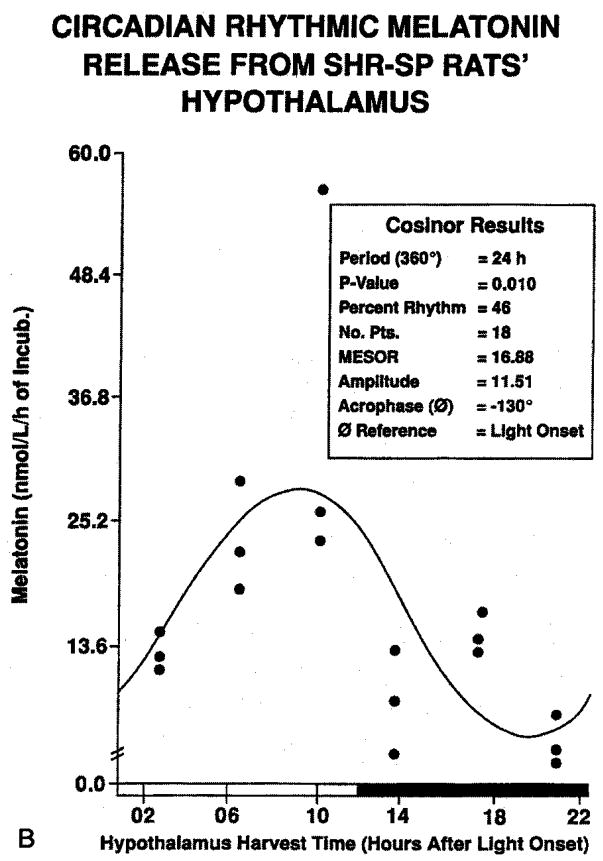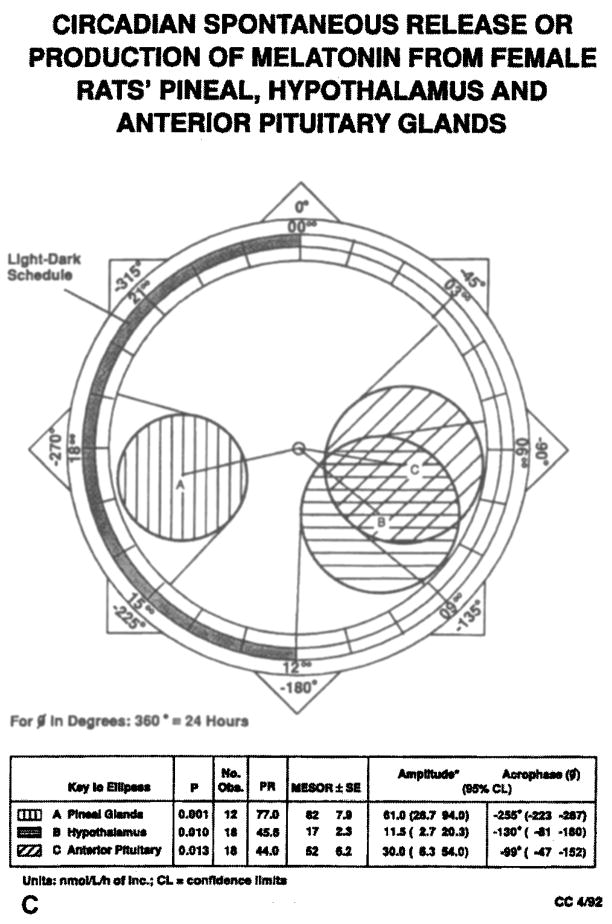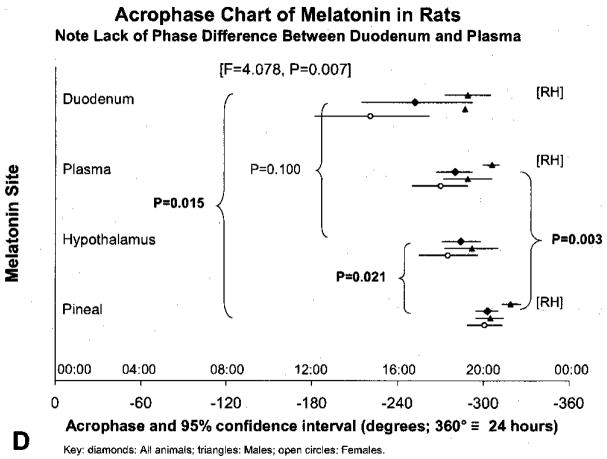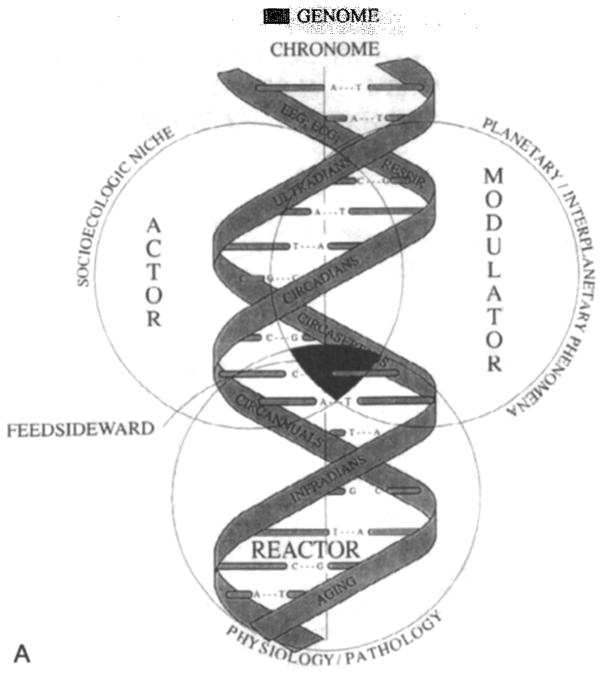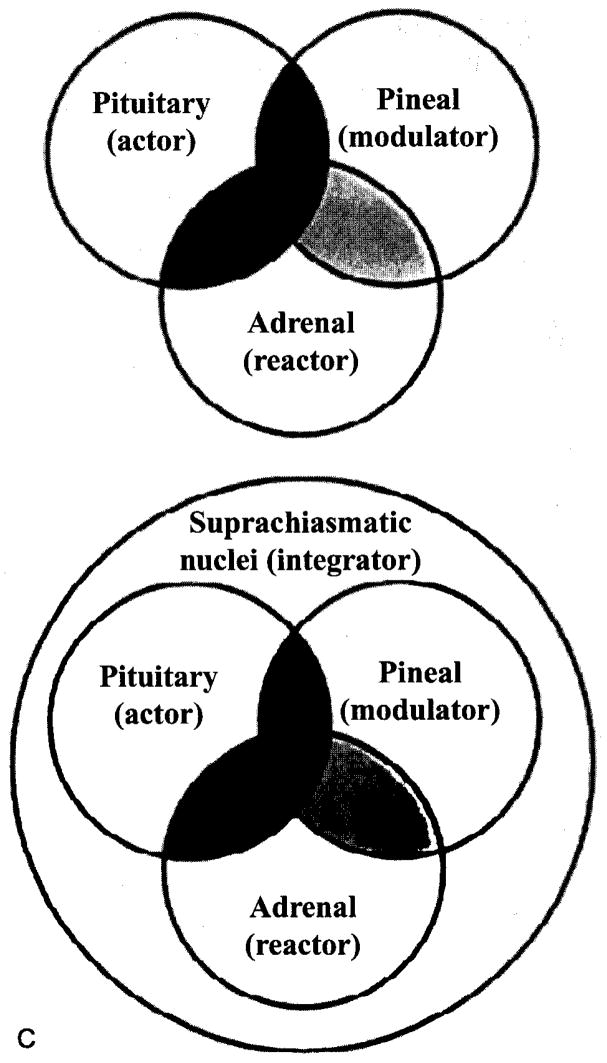Abstract
A multi-center four-hourly sampling of many tissues for 7 days (00:00 on April 5–20:00 to April 11, 2004), on rats standardized for 1 month in two rooms on antiphasic lighting regimens happened to start on the day after the second extremum of a moderate double magnetic storm gauged by the planetary geomagnetic Kp index (which at each extremum reached 6.3 international [arbitrary] units) and by an equatorial index Dst falling to −112 and−81 nT, respectively, the latter on the first day of the sampling. Neuroendocrine chronomes (specifically circadian time structures) differed during magnetically affected and quiet days. The circadian melatonin rhythm had a lower MESOR and lower circadian amplitude and tended to advance in acrophase, while the MESOR and amplitude of the hypothalamic circadian melatonin rhythm were higher during the days with the storm. The circadian parameters of circulating corticosterone were more labile during the days including the storm than during the last three quiet days. Feedsidewards within the pineal-hypothalamic-adrenocortical network constitute a mechanism underlying physiological and probably also pathological associations of the brain and heart with magnetic storms. Investigators in many fields can gain from at least recording calendar dates in any publication so that freely available information on geomagnetic, solar and other physical environmental activity can be looked up. In planning studies and before starting, one may gain from consulting forecasts and the highly reliable nowcasts, respectively.
Keywords: Circadian, Corticosterone, Geomagnetic storm, Hypothalamus, Melatonin, Pineal
1. Introduction
A review by Zhadin [1] traces major interest in biomedical and sociological associations of magnetic fields in Russia to the 1880s. Research on the “physiological action of electricity over a distance” by the physiologist V. Danilevsky, at the turn of the 20th century, was followed by lifetime emphases by V. Vernadsky and A.L. Chizhevsky of the role of “cosmic processes in the rise of life and humanity”, as they put it. Ever since, a heliobiology has been central to (and important far beyond) biomedical science in Russia [2–4]. As in the West, however, inferential statistical approaches were scarce and interval estimates of the periods and other characteristics of any cycles involved were lacking. With notable exceptions [5–12], any transdisciplinary unseen effects of the sun are largely ignored in the West since the intensities involved are low and a plausible mechanism mediating effects seems to be lacking. Burch et al. [13] and Weydahl et al. [14] had earlier reported a decrease in human urinary melatonin in connection with heightened geomagnetic activity. Bardassano et al. [15] observed a reduction in synaptic ribbons of pinealocytes of rats during geomagnetic storms, compared with quiet days. Sliwowska et al. [16], using [125I] melatonin for receptor autoradiography, report on immunoreactive neurons in the hypothalami of sheep as targets for melatonin. This may be the first report of an in situ lower around-the-clock average (MESOR) of melatonin and of a smaller amplitude of its circadian rhythm in the pineal, of the opposite in the hypothalamus and of adrenocortical involvement, in association with a magnetic storm, so that participation by feedsidewards is documented for the rat’s circadian system [17]. An effect of a magnetic storm was studied earlier electron-microscopically [18] and physiologically, and a phase-shift of the rabbit’s cardiac circadian system was documented [19]. But in all these studies a storm effect upon infradians as yet remains unassessed.
2. Materials and methods
In our study, during 7 consecutive days, tissues from inbred Wistar rats were sampled during daytime working hours only at three consecutive 4-h intervals in Pecs, Hungary [20–22]. These animals had been standardized for a month in two rooms, one room on a regimen of light (L) from 09:00 to 21:00, the other in L from 21:00 to 09:00, alternating with darkness (the latter the reversed room). The shift of the circadian body core temperature rhythm was first ascertained in a subsample of rats. That the rhythm of circulating corticosterone in the reversed room had been shifted was found prospectively on the first day of study, by actual around-the-clock blood sampling in each room for 24 h at 4-h intervals. Retrospectively, shifts were established further for plasma melatonin as well as corticosterone by comparison of the profiles obtained by only 12-h/day sampling (from rooms with antiphasic lighting), with data obtained by others and ourselves earlier ([17,23–26]; cf. http://www.msi.umn.edu/~halberg/). The data thus presumably correspond to around-the-clock four-hourly sampling for 7 days, with the qualification that in this particular case any transient effects of excessive magnetic activity remain unassessed by night.
The first days of the 7-day “round the clock study” (with daytime sampling on antiphasic lighting regimens) happened to include and/or follow promptly after a second extremum of a moderate double magnetic storm. Kp reached a value of 6.3 on April 3 at 18:00 and on April 4 at midnight, before the start of the study; Dst fell to −112 nT on April 4 at 00:30 and to −81 nT on April 5 at 19:30, Fig. 1.
Fig. 1.
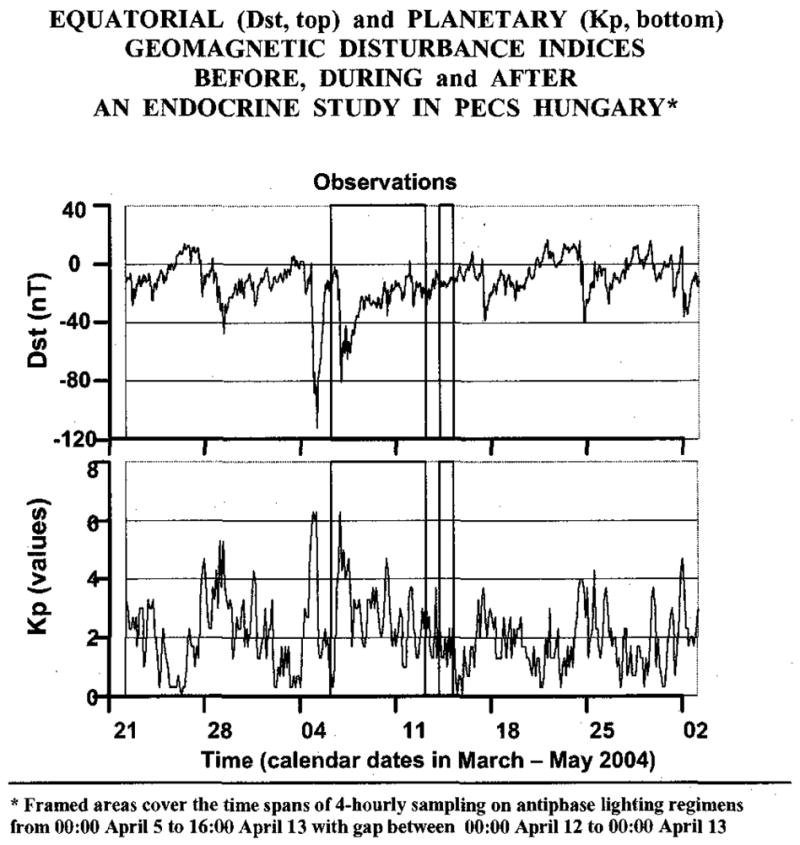
The temporal location of a 7-day endocrine study happening to start at the second extreme of a double magnetic storm. It could not have planned better and a follow-up should be planned as an attempt to replicate it. © Halberg.
The data were analyzed by cosinor [17,23–26] to obtain estimates of the chronome (time structure)-adjusted average (M), of the circadian amplitude (A), a measure of half of the extent of change within a day, and of the circadian acrophase (φ), a measure of the timing of overall high values recurring each day.
3. Results
The MESOR and circadian amplitude were both lower for pineal melatonin and higher for hypothalamic melatonin on the stormy vs. quiet days, Fig. 2. There was a statistically significant interdian difference in parameters (M, A, φ) of the circadian circulating corticosterone rhythm among days 1–3 but not among days 5–7, Table 1.
Fig. 2.
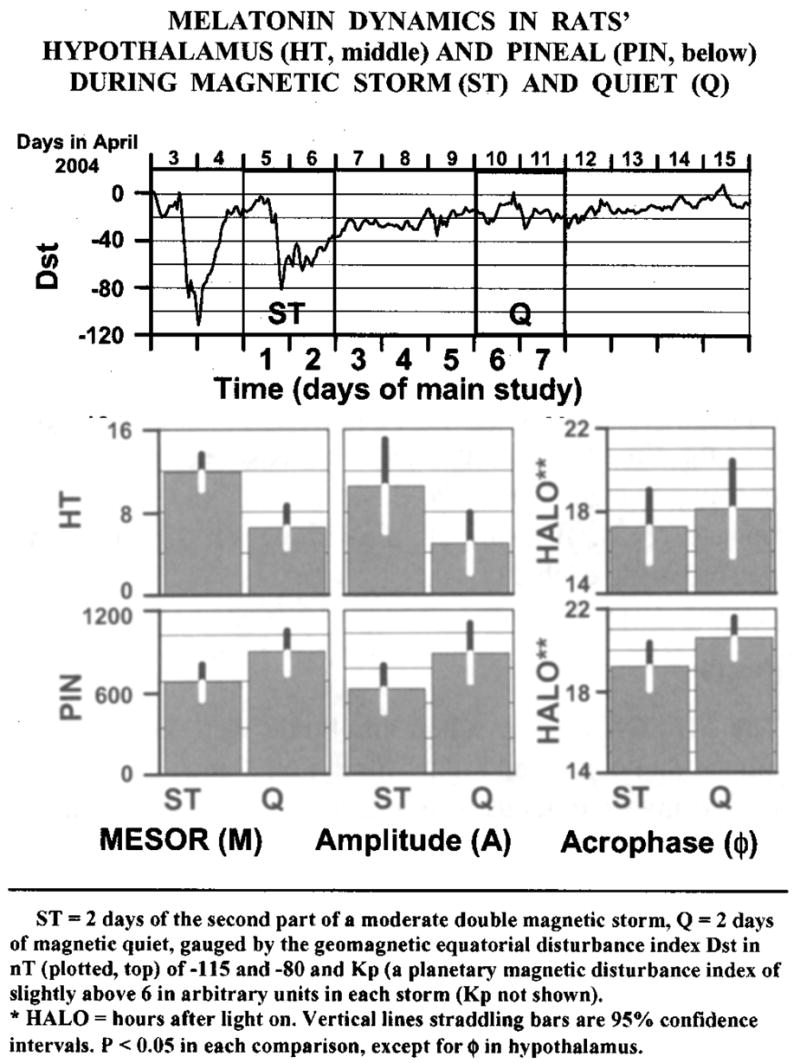
Observations on the equatorial geomagnetic index Dst (top), on the hypothalamus, Ht (middle) that may be activated via the storm directly and/or via the pineal, Pin (bottom). Concerning an effect of the storm (top) upon the neuroendocrine network (below), also showing adrenocortical involvement, Table 1, these unplanned observations on rats can be aligned with observations of a decreased urinary excretion of melatonin during magnetic storms [13,14] in keeping with a damping of pineal function, including its dynamics, gauged by the lower circadian amplitude during the storm. This “experiment of nature” offers a putative mechanism that cannot be dissected in vivo in humans. Nonetheless, post hoc ergo propter hoc reasoning and confounding by any unassessed effects upon circaseptan rhythms cannot be excluded and will require rebuttal or confirmation. A solution may be most readily available if investigators of pineal function check the presence or absence of a magnetic storm during their studies and, if so, compare data from magnetically stormy and quiet days after the cosinor-computation of parameters. In any event, original data or circadian parameters with calendar dates can be sent to corne001@umn.edu for integration with the results summarized herein and elsewhere [28]. ©Halberg.
Table 1.
Circadian alteration of the pineal–hypothalamic–adrenocortical network A double magnetic storm is associated with lower pineal and higher hypothalamic time structure-adjusted MESORs (M) and circadian amplitudes (A) and a possible phase (φ) advance of the pineal circadian rhythm of melatonin (top half), and statistically significant day-to-day variability in M, A and φ of circulating corticosterone during the first study days including the magnetic storm vs. the last quiet days (bottom half). The extent to which this effect represents an infradian storm effect cannot be assessed because of the brevity of the series and the lack of controls.
| Geomagnetics (condition) | Sampling(days of study) | M | A | φ | (A,φ) | (M,A,φ) |
|---|---|---|---|---|---|---|
| Pineal melatonin (pg per tissue) | ||||||
| Stormy | 1–2* | 796.8 | 722.2 | −288 | ||
| Quiet | 6–7 | 1052.9 | 1024.0 | −309 | ||
| P | 0.021 | 0.051 | 0.054 | 0.020 | 0.006 | |
|
| ||||||
| Hypothalamic melatonin (pg/tissue) | ||||||
| Stormy | 1–2* | 11.87 | 10.52 | −258 | ||
| Quiet | 6–7 | 6.48 | 4.92 | −271 | ||
| P | 0.005 | 0.033 | 0.521 | 0.129 | 0.016 | |
|
| ||||||
| Circulating corticosterone† (log10%) | ||||||
| Stormy | 1 | 1.83 | 0.41 | −209 | ||
| 2 | 2.02 | 0.25 | −183 | |||
| 3 | 1.78 | 0.17 | −231 | |||
| P | <0.001 | 0.066 | 0.130 | 0.040 | 0.001 | |
| Quiet | 5 | 1.91 | 0.31 | −209 | ||
| 6 | 2.02 | 0.23 | −235 | |||
| 7 | 2.01 | 0.23 | −196 | |||
| P | 0.410 | 0.754 | 0.439 | 0.652 | 0.643 | |
Results complicated by novelty effect. Difference in MESOR between days 1–2 and 6–7 remains demonstrable for both pineal and hypothalamic melatonin after logl0-transformation of the data (to normalize their distribution).
Data expressed as % of mean in rats of each sex separately, pooled and log10-transformed.
4. Discussion and conclusion
The very small amount of melatonin in the hypothalamus notwithstanding, a circadian melatonin rhythm was earlier demonstrated in this gland and had been shown to differ both in the hypothalamus and in the pituitary in its timing vs. the pineal [27,28]. A lead in phase of the hypothalamic melatonin rhythm was also found in this study, although the effect of a phase difference in the Wistar rats studied herein was smaller than that found in the spontaneously hypertensive stroke-prone rat of dear Kozo Okamoto, Fig. 3 [27,28]. Whether melatonin in the hypothalamus is derived from the pineal or locally or from elsewhere, multiple hypothalamic interaction—time-qualified feedsidewards [17], Fig. 4a–c— rather than time-unqualified feedbacks or feedforwards, may be involved. The adrenal cortex responds directly to melatonin in vitro circadian-periodically and responds, also in vitro, via an effect upon pituitary ACTH secretion. The pineal, hypothalamus and adrenal cortex may all be activated by magnetic storms. The almost certain, indirect or direct, involvement of the hypothalamus in situ, shown perhaps for the first time, in Table 1 and Fig. 2, is in keeping with the findings of the role of emotions associated with both this structure and magnetic storms [17]. The shake-up of adrenal cortical secretion, with ubiquitous central and peripheral effects, provides a mechanism for the varied associations of magnetic storms as well. The manifold associations reported on mood, affect, religious proselytism, wars and cardiovascular pathophysiology now have a plausible mechanism [1,4–10,17]. Ref. [17] is pertinent for a tentative interpretation in the light of Fig. 4a–c.
Fig 3.
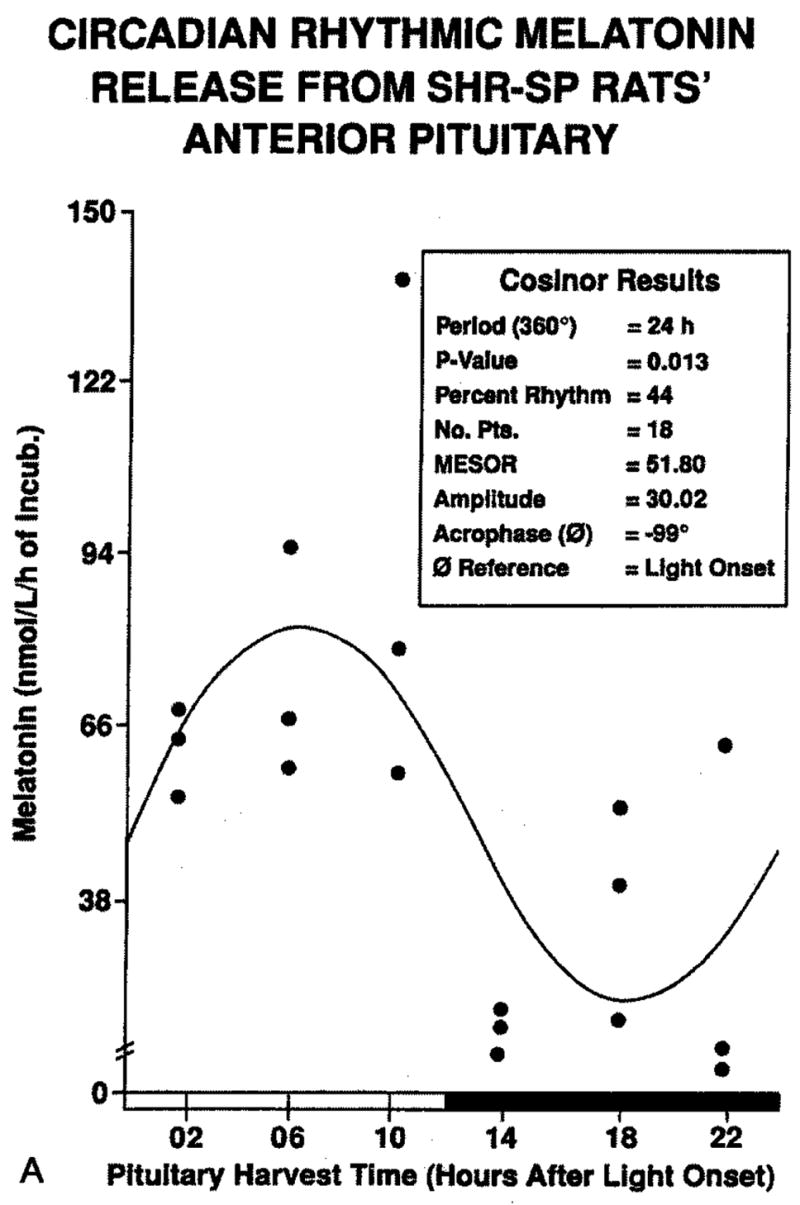
Fig. 3a. Circadian stage-dependence of melatonin in the anterior pituitary gland. Original studies of Dr. Salvador Sanchez de la Peña. ©Halberg.
Fig. 3b. Circadian stage-dependence of melatonin in the hypothalamus. Original studies of Dr. Salvador Sanchez de la Peña. ©Halberg.
Fig. 3c. Cosinor summary indicating the phase relations between the circadian variation of melatonin in the pineal gland, the anterior pituitary gland, and the hypothalamus. Original studies of Dr. Salvador Sanchez de la Peña. ©Halberg.
Fig. 3d. Lead in phase of melatonin in the gut vs. that in the pineal (P < 0.05). Original studies of Dr. Michal Zeman and Dr. Rita Jozsa, and of Dr. Burkhard Pöggeler and DR. Rüdiger Hardeland (RH). ©Halberg.
Fig 4.
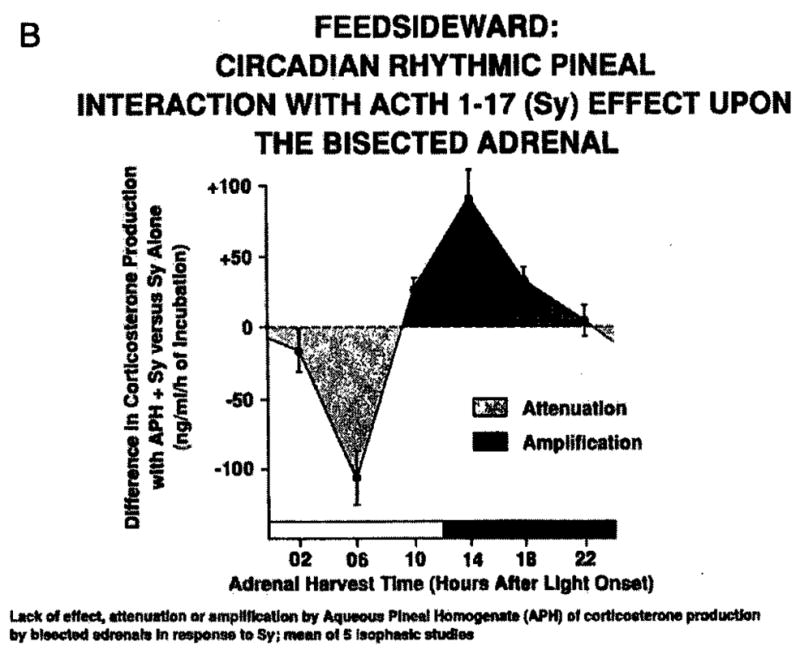
Fig. 4a. Chronomodulation: on the right, a modulator, representing magnetic planetary and interplanetary solar and galactic factors (their effect on geomagnetics is shown in Fig. 1) are conceived as normally modulating or, as storms, altering the socioecological conditions in the habitat, e.g. the synchronizing effect of the lighting regimen (the actor) in the animal room, acting upon the organismic hypothalamic-pineal (Fig. 2)-adrenocortical (Table 1)-vascular network. ©Halberg
Fig. 4b. Lack of effect, attenuation, or amplification by aqueous pineal homogenate (APH) of corticosterone production by bisected adrenals in response to a synthetic ACTH 1–17, Synchrodyn (Sy). When magnetic storms reach an organism, their effect will depend upon the network’s stage at exposure times, in the case of a double storm shown in Fig. 1. ©Halberg.
Fig. 4c. Results such as those in Fig. 2b are summarized on top. The second diagram from the top illustrates the effect of the suprachiasmatic nuclei (SCN) on circadian amplitude and acrophase. The finding (not shown) of a zero circadian amplitude indicating a lacking rhythm is the result of SCN removal in the case of locomotor activity and water drinking does not apply to a vast majority of other rhythms sampled at 4-h or shorter intervals for 24 h or longer spans and analyzed by inferential statistical means. The consistent findings after SCN removal are changes in circadian amplitude and/or acrophase, and these are consistent with those in Fig. 2. ©Halberg.
The use of rooms with staggered lighting, beyond investigations of the variables here studied may also be of interest to laboratory investigators broadly: The qualification that any transient effects of magnetic storms by night will be missed, because of the antiphasic sampling design, stands, as noted above. It is also clear, however, that the effects were sufficiently prominent to be seen by sampling only during daytime.
Still more generally, investigators, not only of pineal, hypothalamic and adrenocortical function, may review geomagnetic activity in past studies, record it at least as dates in publications, and in the future may consult those who predict space weather, which in part drives geomagnetic activity [29–31 ]. It seems reasonable to suggest that experiments be planned flexibly, so as to be able to postpone the start of a study when a magnetic storm is predicted by planetary K-indices and/or the equatorial Dst index and/or by many other correlated means. Looking at storms’ antecedents in the sun before starting a study is an added precaution, complementing the standardization of lighting [ 17,32]. It is being practiced by investigators experienced in this field [33,34]. A solar and geophysical activity report and 3- day forecast are available at http://sec.noaa.gov/forecast.html. Information about this product is at http://sec.noaa.gov/forecasts/RSGA/README.
The new evidence herein shows a pathway for the sometimes devastating magnetic storm effects [ 1,9,10], including those upon the rabbit heart described in the laboratory [ 18,19] and epidemiologically, with human data on myocardial infarction and sudden cardiac death [9,10,35,36]. Great geographic differences in the chronoepidemiology of sudden cardiac death after the 10th revision of the International Classification of Diseases (ICD 10, code I46.1), suggest that the large magnet earth may modify the effect of the huge but far magnet sun [35]. Whether the stock market is also dramatically involved [37] is rightly being investigated, although a sign test does not yet allow a definitive conclusion on the data of Fig. V in [37]. It would not be surprising in view of early [38,39] and more recent [40–42] references to space weather and crops to find transdisciplinary effects by rigorous methodology even upon growth [43]. Looking up a space weather report when past, present and future studies were done is simple and in many ways rewarding. It certainly prompted this report.
Acknowledgments
E T T 82/2003 (R.J.); OTKA 04370, VEGA1/1294/04 (M.Z.), GM-13981 (F.H.) and Dr. h.c. mult. Earl Bakken Fund (F.H., G.C.).
References
- 1.Zhadin MN. Bioelectromagnetics. 2001;22:27–45. doi: 10.1002/1521-186x(200101)22:1<27::aid-bem4>3.0.co;2-2. [DOI] [PubMed] [Google Scholar]
- 2.Breus TK, Rapoport SI. Magnitnie bure: medico-biologicheskie i geofizicheskie aspekti. Moscow: Sovetskiy Sport Izdatel’stvo; 2003. p. 192. [Google Scholar]
- 3.Breus TK, Chibisov SM, Baevsky RM, Schebzuhov KV. The chronostructure of heart biorhythms under effects of external environment factors. Moscow: Russian University of People’s Friendship, Polygraph Service; 2002. p. 231. [Google Scholar]
- 4.Breus T, Cornélissen G, Halberg F, Levitin AE. Temporal associations of life with solar and geophysical activity. Ann Geophys. 1995;13:1211–22. [Google Scholar]
- 5.Mikulecky M, editor. Kosice, Slovakia, September 23–25, 1993. Bratislava: Slovak Medical Society; 1993. The Moon and living matter; p. 97. [Google Scholar]
- 6.Mikulecky M, editor. Bratislava, Slovakia, June 28-July 1, 1994. Bratislava: Slovak Medical Society; 1994. Sun, Moon and living matter; p. 159. [Google Scholar]
- 7.Mikulecky M, editor. High Tatras, Slovakia, September 2–6, 1997. Bratislava: Slovak Medical Society; 1997. Chronobiology and its roots in the cosmos; p. 287. [Google Scholar]
- 8.Mikulecky M, Duffs I. Chronocosmobiology and chronocosmomedicine in Slovakia: the legacy of Academician Ladislav Derer. Proc. 3rd International Symposium of Chronobiology and Chronomedicine; Kunming, China. October 7–12, 1998; pp. 56–7. [Google Scholar]
- 9.Halberg F, Cornélissen G, Otsuka K, Watanabe Y, Katinas GS, Burioka N, et al. International BIOCOS Study Group. Cross-spectrally coherent ~ 10.5- and 21-year biological and physical cycles, magnetic storms and myocardial infarctions. Neuroendocrinol Lett. 2000;21:233–58. [PubMed] [Google Scholar]
- 10.Cornélissen G, Halberg F, Breus T, Syutkina EV, Baevsky R, Weydahl A, et al. Non-photic solar associations of heart rate variability and myocardial infarction. J Atmos Solar-Terr Phys. 2002;64:707–20. [Google Scholar]
- 11.Halberg F, Cornélissen G, Otsuka K, Schwartzkopff O, Halberg J, Bakken EE. Chronomics. Biomed Pharmacother. 2001;55(Suppl 1):153–90. [PubMed] [Google Scholar]
- 12.Halberg F, Cornélissen G, Regal P, Otsuka K, Wang ZR, Katinas GS, et al. Chronoastrobiology: proposal, nine conferences, heliogeomagnetics, transyears, near-weeks, near-decades, phylogenetic and ontogenetic memories. Biomed Pharmacother. 2004;58(Suppl 1):S 150–87. doi: 10.1016/s0753-3322(04)80025-8. [DOI] [PubMed] [Google Scholar]
- 13.Burch JB, Reif JS, Yost MG. Neurosci Lett. 1999;266:209–12. doi: 10.1016/s0304-3940(99)00308-0. [DOI] [PubMed] [Google Scholar]
- 14.Weydahl A, Sothern RB, Cornélissen G, Wetterberg L. Biomed Pharmacother. 2001;55:57–62. doi: 10.1016/s0753-3322(01)90006-x. [DOI] [PubMed] [Google Scholar]
- 15.Bardasano JL, Cos S, Picazo ML. J Hirnforschung. 1989;30:639–43. [PubMed] [Google Scholar]
- 16.Sliwowska JH, Billings HJ, Goodman RL, Coolen LM, Lehman MN. Biol Reprod. 2004;70:1768–75. doi: 10.1095/biolreprod.103.024182. [DOI] [PubMed] [Google Scholar]
- 17.Halberg F, Cornélissen G, Katinas GS, Watanabe Y, Otsuka K, Maggioni C, et al. Ann NY Acad Sci. 2000;917:348–76. doi: 10.1111/j.1749-6632.2000.tb05401.x. [DOI] [PubMed] [Google Scholar]
- 18.Breus TK, Pimenov KYu, Cornélissen G, Halberg F, Syutkina EV, Baevsky RM, et al. The biological effects of solar activity. Biomed Pharmacother. 2002;56(Suppl 2):273s–83s. doi: 10.1016/s0753-3322(02)00302-5. [DOI] [PubMed] [Google Scholar]
- 19.Chibisov SM, Cornélissen G, Halberg F. Biomed Pharmacother. 2004;58(Suppl 1):S15–9. doi: 10.1016/s0753-3322(04)80003-9. [DOI] [PubMed] [Google Scholar]
- 20.Jozsa R, Olah A, Cornélissen G, Csernus V, Otsuka K, Zeman M, et al. This issue. Circadian and extracircadian exploration during daytime hours of circulating corticosterone and other endocrine chronomes; pp. S109–S116. [DOI] [PMC free article] [PubMed] [Google Scholar]
- 21.Zeman M, Jozsa R, Cornélissen G, Stebelova K, Bubenik G, Olah A, et al. This issue. Chronomics: circadian lead of murine extrapineal vs. pineal melatonin rhythms with an infradian hypothalamic exploration; pp. $213–$219. [DOI] [PubMed] [Google Scholar]
- 22.Stebelova K, Zeman M, Cornélissen G, Bubenik G, Jozsa R, Hardeland R, et al. Chronomics reveal and quantify circadian rhythmic melatonin in duodenum of rats. This issue. :$209–$212. doi: 10.1016/s0753-3322(05)80033-2. [DOI] [PMC free article] [PubMed] [Google Scholar]
- 23.Halberg F, Tong YL, Johnson EA. Circadian system phase—an aspect of temporal morphology; procedures and illustrative examples. In: Mayersbach Hv., editor. Proc International Congress of Anatomists. The cellular aspects of biorhythms, symposium on biorhythms. New York: Springer-Verlag; 1967. pp. 20–48. [Google Scholar]
- 24.Halberg F, Johnson EA, Nelson W, Runge W, Sothern R. Autorhythmometry—procedures for physiologic self-measurements and their analysis. Physiol Ther. 1972;1:1–11. [Google Scholar]
- 25.Halberg F. Chronobiology. Annu Rev Physiol. 1969;31:675–725. doi: 10.1146/annurev.ph.31.030169.003331. [DOI] [PubMed] [Google Scholar]
- 26.Cornélissen G, Halberg F. Chronomedicine. In: Armitage P, Colton T, editors. Encyclopedia of biostatistics. 2. Chichester, UK: John Wiley & Sons Ltd; 2005. pp. 796–812. [Google Scholar]
- 27.Brown GM, Sanchez de la Peña S, Marques N, Grota LJ, Ungar F, Halberg F. More on the circadian melatonin rhythm in pineals from domesticated B 6D2F 1 mice. Chronobiologia. 1986;13:335–8. [PubMed] [Google Scholar]
- 28.Halberg F, Cornélissen G, Conti A, Maestroni G, Maggioni C, Perfetto F, et al. The pineal gland and chronobiologic history: mind and spirit as feedsidewards in time structures for prehabilitation. In: Bartsch C, Bartsch H, Blask DE, Cardinali DP, Hrushesky WJM, Mecke W, editors. The pineal gland and cancer: neuroimmunoendocrine mechanisms in malignancy. Heidelberg: Springer; 2001. pp. 66–116. [Google Scholar]
- 29.Dryer M. Interplanetary shock waves generated by solar flares. Space Sci Rev. 1974;15:403–68. [Google Scholar]
- 30.Dryer M. Interplanetary studies: propagation of disturbances between the sun and the magnetosphere. Space Sci Rev. 1994;67:363–419. [Google Scholar]
- 31.Dryer M. Comments on the origins of coronal mass ejections. Solar Phys. 1996;169:421–9. [Google Scholar]
- 32.Halberg E, Halberg F. Chronobiologic study design in everyday life, clinic and laboratory. Chronobiologia. 1980;7:95–120. [PubMed] [Google Scholar]
- 33.Persinger MA, Healey F. Experimental facilitation of the sensed presence: possible intercalation between the hemispheres induced by complex magnetic fields. J Nervous Ment Dis. 2002;190:533–41. doi: 10.1097/00005053-200208000-00006. [DOI] [PubMed] [Google Scholar]
- 34.Persinger MA. Religious and mystical experiences as artifacts of temporal lobe function: a general hypothesis. Percept Motor Skills. 1983;57:1255–62. doi: 10.2466/pms.1983.57.3f.1255. [DOI] [PubMed] [Google Scholar]
- 35.Halberg F, Breus TK, Cornélissen G, Bingham C, Hillman DC, Rigatuso J, et al. International Womb-to-Tomb Chronome Initiative Group: Chronobiology in space. Keynote, 37th Ann. Mtg. Japan Soc. for Aerospace and Environmental Medicine; Nagoya, Japan. November 8–9, 1991; University of Minnesota/Medtronic Chronobiology Seminar Series; #1, December 1991, 21 pp. of text, 70 figures. [Google Scholar]
- 36.Halberg F, Cornélissen G, Otsuka K, Fiser B, Mitsutake G, Wendt HW, et al. This issue. Incidence of sudden cardiac death, myocardial infarction and far- and near-transyears; pp. $239–$261. [DOI] [PubMed] [Google Scholar]
- 37.Krivelyova A, Robotti C. Federal Reserve Bank of Atlanta, Working Paper 2003–5b. 2003 October;:53. [ http://www.frbatlanta.org/file-legacydocs/wp0305b.pdf]
- 38.Clarke H. On the political economy and capital of joint stock banks. Railway Mag. 1838;27:288–93. (cited in Editor’s Comments on Papers 29 through 36, in Schove DJ (Ed.). Sunspot Cycles. Benchmark Papers in Geology/68. Stroudsburg, PA: Hutchinson Ross, 1983. pp. 226–38). [Google Scholar]
- 39.Clarke H. Physical economy: a preliminary inquiry into the physical laws goveming the periods of famines and panics. Railway Register, 1847 (cited in Editor’s Comments on Papers 29 through 36. In: Schove DJ, editor. Sunspot Cycles. Benchmark Papers in Geology/68. Stroudsburg, PA: Hutchinson Ross; 1983. pp. 226–38. [Google Scholar]
- 40.Rostoker G. Nowcasting of space weather using the CANOPUS magnetometer array. Physics in Canada/La Physique au Canada. 1998 Sept./Oct.:277–84. [Google Scholar]
- 41.Turtoi C, Cornélissen G, Wilson D, Halberg F. About 21-year Hale cyclic signature in agriculture complements those in biomedicine. Biomed Pharmacother. 2004;58(Suppl 1):S12–4. doi: 10.1016/s0753-3322(04)80002-7. [DOI] [PubMed] [Google Scholar]
- 42.Regal P, Cornélissen G, Turtoi C, Wilson D, Halberg F. Chronomes of crop yields: solar magnetic cycles implicated in year-to-year variations. Abstract (Read by Title) 4. In: Matsubayasi K, editor. Proceedings, 5th International Workshop on Chronoastrobiology and Chronotherapy. Division of Human-Nature Dynamics, Center for Southeast Asian Studies; Nov 6, 2004. pp. 51–4. [Google Scholar]
- 43.Komlos J, Cornélissen G, Woitek U, Otsuka K, Halberg F. Time structure, chronomes, of soldiers’s stature mimicking Hale cycle in neonatal body length. Biomed Pharmacother. 2004;58(Supp 1):S135–S139. doi: 10.1016/s0753-3322(04)80022-2. [DOI] [PubMed] [Google Scholar]



